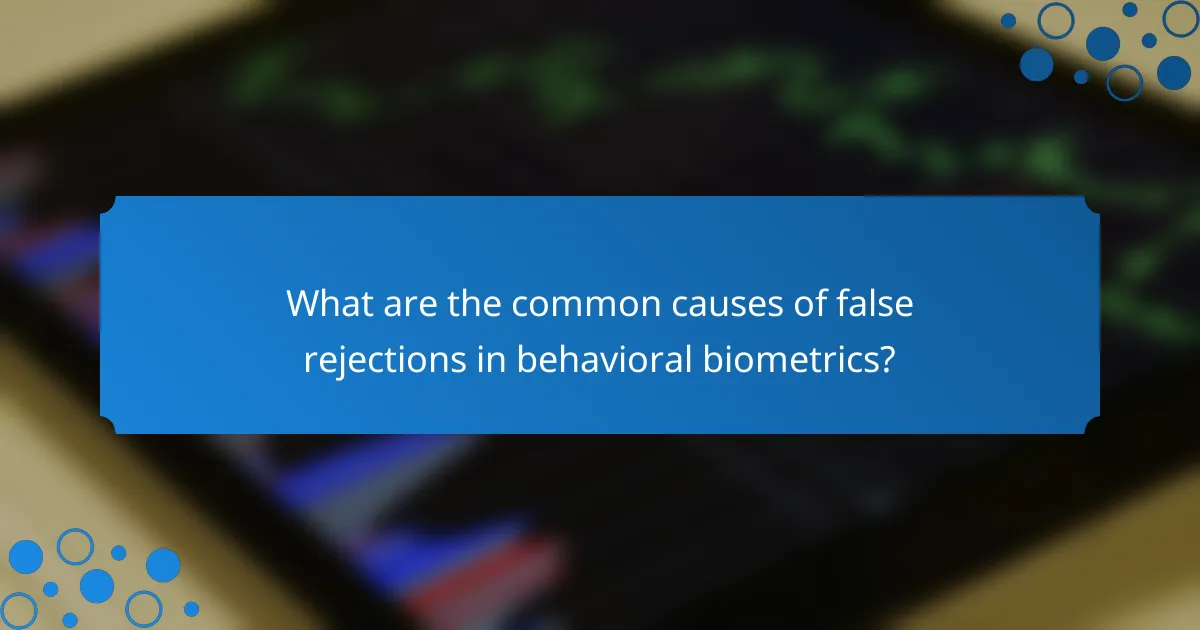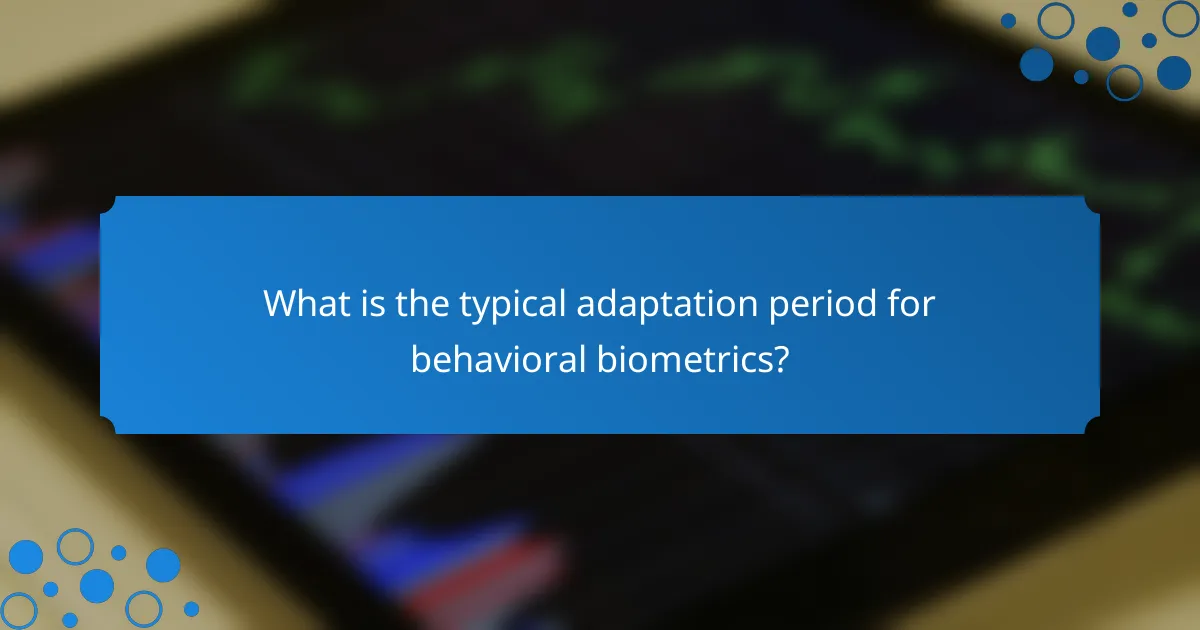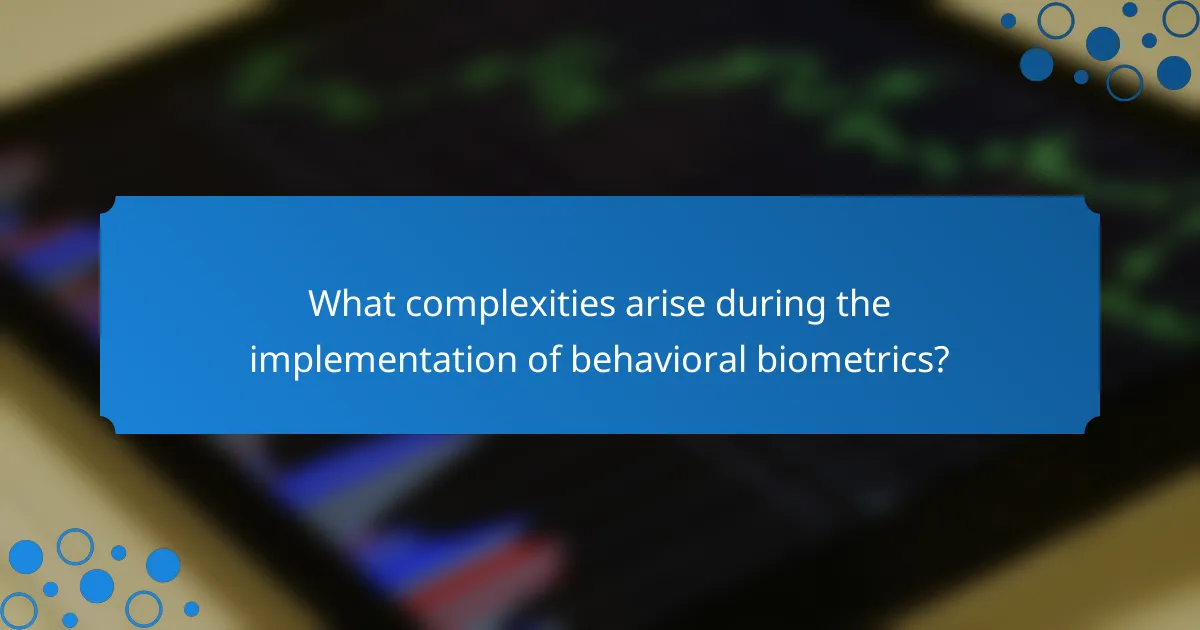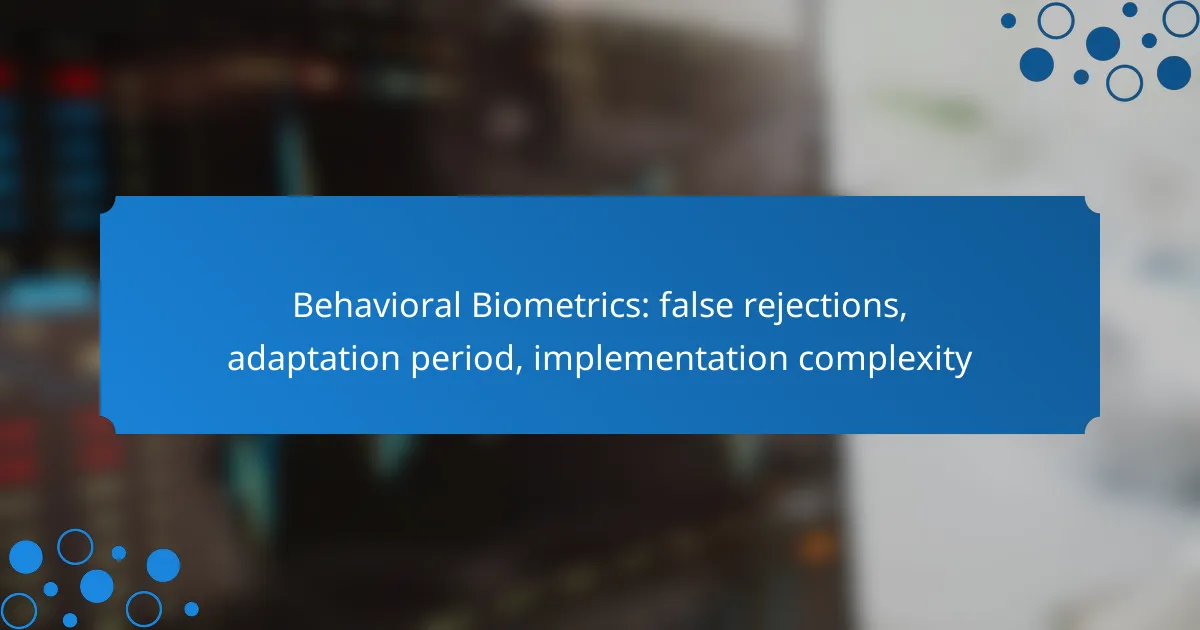Behavioral biometrics offers a unique approach to identity verification by analyzing user behavior patterns; however, it faces challenges such as false rejections, where legitimate users are mistakenly flagged as unauthorized. To address this, systems often require an adaptation period of one to three weeks to accurately learn and adjust to individual user behaviors. Implementing advanced techniques, including adaptive learning algorithms and regular updates, is essential to minimize these errors and enhance overall accuracy.

What are the common causes of false rejections in behavioral biometrics?
False rejections in behavioral biometrics occur when legitimate users are incorrectly identified as unauthorized. This can stem from various factors, including inaccuracies in user behavior models, environmental influences, and changes in user habits over time.
Inaccurate user behavior models
Behavioral biometrics relies on models that analyze user patterns, such as typing speed or mouse movement. If these models are not accurately calibrated to reflect a user’s typical behavior, they may lead to false rejections. Regular updates and training of these models are essential to minimize errors.
Environmental factors affecting data collection
Environmental conditions, such as lighting, noise, or even the physical setup of a workstation, can significantly impact data collection. For instance, a noisy environment may disrupt a user’s typing rhythm, leading to discrepancies in behavior analysis. Ensuring a consistent environment during data collection can help reduce false rejections.
Device compatibility issues
Different devices may capture user behavior differently, which can lead to inconsistencies in biometric assessments. For example, a user may have a different typing style on a mobile device compared to a desktop. It’s crucial to ensure that the biometric system is compatible with the devices being used to maintain accuracy.
User anxiety or stress
Psychological factors, such as anxiety or stress, can alter a user’s behavior, impacting their biometric data. A user under pressure may type more slowly or erratically, which can trigger false rejections. Providing a calm and familiar environment can help users perform more consistently.
Changes in user behavior over time
User behavior is not static; it can evolve due to various factors like age, health, or changes in routine. These shifts can lead to discrepancies in biometric recognition. Implementing adaptive learning algorithms that adjust to gradual changes in behavior can help mitigate the risk of false rejections.

How can false rejections be minimized in Canada?
Minimizing false rejections in Canada involves implementing advanced techniques that enhance the accuracy of behavioral biometrics. Key strategies include adaptive learning algorithms, improved data quality, and regular updates to user profiles.
Implement adaptive learning algorithms
Adaptive learning algorithms adjust to user behavior over time, reducing the likelihood of false rejections. These algorithms analyze patterns and anomalies in user interactions, allowing the system to become more attuned to individual habits.
For example, if a user typically types at a certain speed but has a temporary change due to a new device, the algorithm can learn this deviation and avoid flagging it as suspicious. This flexibility is crucial in maintaining user access without compromising security.
Enhance data quality and collection methods
High-quality data collection is essential for accurate behavioral biometrics. Employing diverse methods such as keystroke dynamics, mouse movements, and touch patterns can provide a more comprehensive view of user behavior.
In Canada, ensuring compliance with privacy regulations while collecting this data is vital. Organizations should focus on obtaining user consent and implementing secure data storage practices to maintain trust and protect sensitive information.
Regularly update user profiles
Regular updates to user profiles can significantly reduce false rejections by reflecting changes in behavior. This can include periodic reviews of user interactions and adjustments based on new data collected.
For instance, if a user’s typing speed or device usage changes, updating their profile can help the system recognize these variations. Establishing a routine for profile updates, such as every few months, can enhance the system’s adaptability and accuracy.

What is the typical adaptation period for behavioral biometrics?
The typical adaptation period for behavioral biometrics ranges from one to three weeks. During this time, the system learns and adjusts to the unique patterns of a user’s behavior, enhancing accuracy in identity verification.
Initial learning phase of 1-3 weeks
The initial learning phase is crucial for establishing a baseline of user behavior. This phase typically lasts between one to three weeks, during which the system collects data on various behavioral traits, such as typing speed, mouse movements, and navigation patterns. The duration may vary based on the frequency of user interactions with the system.
During this period, users may experience a higher rate of false rejections as the system is still calibrating to their specific behaviors. It is essential for users to engage consistently with the system to facilitate accurate learning.
Factors affecting adaptation duration
Environmental factors, such as changes in device settings or user context, can also impact the adaptation time. For instance, switching from a desktop to a mobile device may require additional time for the system to adjust to new input methods.
Variability based on user behavior
User behavior can vary widely, affecting how quickly a behavioral biometrics system adapts. Individuals with consistent and predictable patterns may see faster adaptation compared to those with erratic behaviors. For example, a user who types at a steady pace will likely be recognized more quickly than someone whose typing speed fluctuates significantly.
Moreover, external factors such as stress or fatigue can temporarily alter a user’s behavior, potentially leading to increased false rejections during the adaptation phase. Users should be aware of these influences and try to maintain consistent usage patterns for optimal system performance.

What complexities arise during the implementation of behavioral biometrics?
Implementing behavioral biometrics involves several complexities, including integration with existing security systems, data privacy concerns, and the need for staff training. Each of these factors can significantly impact the effectiveness and efficiency of the deployment process.
Integration with existing security systems
Integrating behavioral biometrics into current security frameworks can be challenging due to compatibility issues. Organizations often use a variety of security measures, and ensuring that new biometric systems work seamlessly with these can require significant technical adjustments.
It’s essential to assess the architecture of existing systems and identify potential integration points. This may involve custom development or the use of middleware, which can increase costs and implementation time.
Data privacy and compliance challenges
Behavioral biometrics raises important data privacy issues, particularly regarding user consent and data protection regulations. Organizations must navigate laws such as the General Data Protection Regulation (GDPR) in Europe, which mandates strict guidelines on data collection and processing.
Ensuring compliance may require implementing robust data governance policies and conducting regular audits. Organizations should also communicate transparently with users about how their behavioral data will be used to build trust and comply with legal standards.
Training staff on new technologies
Training staff to effectively use and manage behavioral biometric systems is crucial for successful implementation. Employees need to understand not only how to operate the technology but also the underlying principles of behavioral biometrics.
Consider developing a comprehensive training program that includes hands-on sessions and ongoing support. This will help staff adapt to the new systems and reduce the likelihood of errors that could compromise security.

What are the prerequisites for successful implementation?
Successful implementation of behavioral biometrics requires a clear understanding of the technology, a robust data collection strategy, and a commitment to continuous adaptation. Organizations must also consider user privacy and compliance with relevant regulations.
False Rejections
False rejections occur when legitimate users are incorrectly identified as threats, leading to denied access. This can frustrate users and undermine trust in the system. To minimize false rejections, it’s crucial to calibrate the system’s sensitivity based on user behavior patterns.
Consider implementing a feedback loop where users can verify their identity through alternative methods if rejected. This not only enhances user experience but also helps the system learn and adapt over time.
Adaptation Period
The adaptation period is the time required for the behavioral biometrics system to learn and adjust to individual user patterns. This phase is essential for achieving accurate recognition and reducing false rejections. Typically, this period can range from a few days to several weeks, depending on user activity levels.
During the adaptation phase, it’s beneficial to monitor user interactions closely. Frequent updates and adjustments can help the system become more attuned to specific behaviors, ensuring better accuracy in the long run.
Implementation Complexity
Implementation complexity refers to the challenges organizations face when integrating behavioral biometrics into existing security frameworks. Factors such as system compatibility, user training, and data privacy regulations can complicate the process. A well-planned strategy can mitigate these issues.
Start with a pilot program to test the technology in a controlled environment before full-scale deployment. This allows for troubleshooting and adjustments without widespread disruption. Additionally, ensure that all stakeholders are trained on the new system to facilitate a smoother transition.
